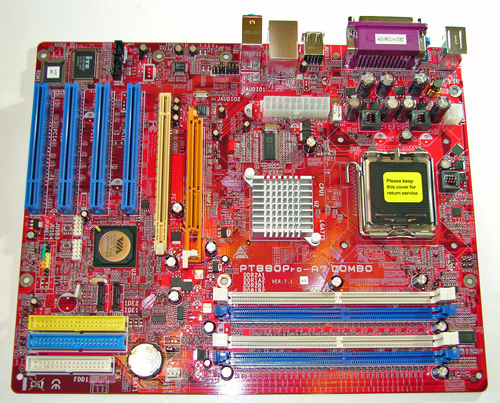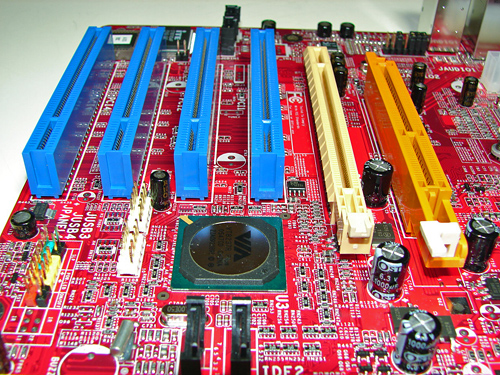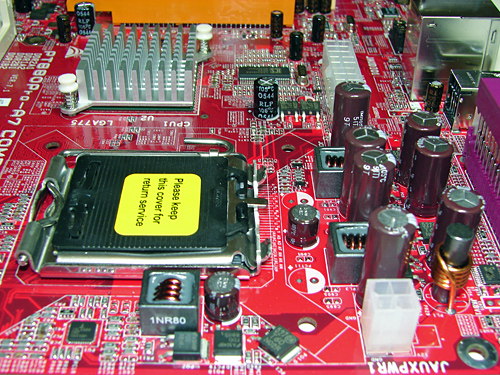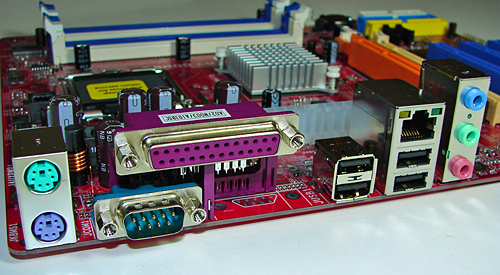VIA PT880 PRO: Biostar’s Deluxe Dual Combo
by Gary Key on March 20, 2006 12:05 AM EST- Posted in
- Motherboards
Biostar PT880 Pro-A7 Combo
The VIA VT8237R SATA ports are located above the IDE connectors. The SATA ports feature the newer clamp-and-latch design. Unlike other recently reviewed boards, the SATA ports are not color-coded for primary and secondary operation, though that is a minor concern. We found the positioning of the SATA ports to be very good when utilizing the PCI slots or IDE port connectors.
The VIA VT8237R chipset is not passively or actively cooled while being located above the SATA ports. The VIA USB connectors and chassis panel are located to the left of the VT8237R chipset.
The orange AGP 3.0 connector is located first, the yellow physical X16 connector is located next, and these are followed by the (4) 32-bit PCI slots. We did not have any issues installing our NVIDIA 6800 Ultra in the AGP 3.0 slot, though this configuration will physically render the X16 PCI Express slot useless. We did not have any issues utilizing this slot with video cards containing single slot cooling systems.
On the PCI Express side, we were also able to install our EVGA 7800GTX 512MB or ATI X1900XTX video cards in the X16 slot without difficulty. This configuration will physically render the first PCI slot useless. Naturally, utilizing this slot with video cards containing single slot cooling systems did not pose any problems.
The VIA PT880 PRO chipset is passively cooled with a low rise heat sink unit that did not interfere with any installed peripherals. In fact, this unit kept the chipset cool enough that additional chipset voltage was not a factor in our overclocking tests.
Due to the location of the CPU fan header, users with 24-pin ATX connectors that cannot be split apart (i.e. detach the extra 4-pin connector) will not be able to use their power supplies without an adapter. Biostar utilizes a 3-phase power regulation system that did not create issues in our testing, but we notice V-core voltage fluctuations when trying to overclock the board.



The VIA VT8237R SATA ports are located above the IDE connectors. The SATA ports feature the newer clamp-and-latch design. Unlike other recently reviewed boards, the SATA ports are not color-coded for primary and secondary operation, though that is a minor concern. We found the positioning of the SATA ports to be very good when utilizing the PCI slots or IDE port connectors.
The VIA VT8237R chipset is not passively or actively cooled while being located above the SATA ports. The VIA USB connectors and chassis panel are located to the left of the VT8237R chipset.

The orange AGP 3.0 connector is located first, the yellow physical X16 connector is located next, and these are followed by the (4) 32-bit PCI slots. We did not have any issues installing our NVIDIA 6800 Ultra in the AGP 3.0 slot, though this configuration will physically render the X16 PCI Express slot useless. We did not have any issues utilizing this slot with video cards containing single slot cooling systems.
On the PCI Express side, we were also able to install our EVGA 7800GTX 512MB or ATI X1900XTX video cards in the X16 slot without difficulty. This configuration will physically render the first PCI slot useless. Naturally, utilizing this slot with video cards containing single slot cooling systems did not pose any problems.

The VIA PT880 PRO chipset is passively cooled with a low rise heat sink unit that did not interfere with any installed peripherals. In fact, this unit kept the chipset cool enough that additional chipset voltage was not a factor in our overclocking tests.

Due to the location of the CPU fan header, users with 24-pin ATX connectors that cannot be split apart (i.e. detach the extra 4-pin connector) will not be able to use their power supplies without an adapter. Biostar utilizes a 3-phase power regulation system that did not create issues in our testing, but we notice V-core voltage fluctuations when trying to overclock the board.











17 Comments
View All Comments
Myrandex - Tuesday, March 21, 2006 - link
I don't know of any desktop level chipset supporting 6 slots, you are being unrealistic here. 4 is about the most you could hope for.4x PCiE is disapointing.
Jason
DigitalFreak - Monday, March 20, 2006 - link
Another crap chipset from a crap vendor.Marlin1975 - Monday, March 20, 2006 - link
Set the memory to 166MHz before trying to overclock. I found this worked best and got me past 205MHz FSB setting. But at 200Mhz memory (ddr1) it would hold or freeze.I have had an Asrock and a Asus PT880 pro board and both worked well. I now have the Asus with an 805 chip. The Asus board has the best sound from all the PT880 pro boards I have seen so far and that is why I gave up the Asrock. Also since the 805 chip starts at 133MHz fsb overclocking seems to work better. That and the 805 would be a better choice to review this type of board based on price. So how about trying the Asus with a 805, or even this biostar with a 805.
Marlin
Gary Key - Monday, March 20, 2006 - link
We tried the 166MHz level and were able to overclock at the 14x multiplier up to a 215FSB but the board was not stable enough to complete our benchmark tests and would generate a ream of errors in MemTest86. We also tried the 15x muliplier with the same results. This issue occurred with two different bios revisions also. We believe either our board or the bios just has an issue with running the CPU at a multiplier other than stock.
While a Pentium D 805 or a newer Celeron D CPU is the most likely CPU candidate along with an 6600GT or X800 video card for this board we did not have the schedule time to go back and test the other boards with these configurations. In fact, our Intel platforms will be moving away from the 840EE after the next review and to a more recent Pentium D processor along with a change in the GPU choice.
Thank you for the comments and suggestions.
hans007 - Monday, March 20, 2006 - link
i think you guys "the reviewers" made a pretty crappy choice of video cards to benchmark this with.this board is clearly meant for someone who is say ... just trying to do a budget upgrade, not someone who can afford a x1900xtx or 7800gtx.
the benchmark scores make it look like an awful board because of the x4 slot limiting the video bandwidth. i think if you benched it with a more realistic bunch of cards such as say 6600gt, or 6800gs etc, it'd be much closer as those cards are probably not as affected by the x4 slot.
Visual - Monday, March 20, 2006 - link
well, we know the regular excuses about this - the card is the same as all other reviews so that results can be comparable, and so the reviewers don't need to actually run tests with other boards (they already have the scores ready)also, i can imagine someone using a board like this if they want to stick with their AGP card for the time being, especially if its one of the fastest models. and later they would upgrade to something fast on the PCIe and expect a good performance, so its good that the review shows that isn't the case.
for people simply going budget, this board doesn't make sense. none of the "combo" features are really needed if you go with a cheap pcie vidcard and a small ddr2 stick.
i was actually surprised someone bothered to make a board like this - intel moved to ddr2 ages ago and i can hardly see anyone needing ddr mobos by now... and even if they did there are plenty of ddr mobos already. and pcie is the standard for quite some time now... it would've made sense right after the intro of pcie, when someone might've wanted to stick with their expencive 6800gt, but now those agp cards are just not worth keeping for the "slow upgrade" route.
jm20 - Monday, March 20, 2006 - link
n the performance area, the Biostar TForce4 U 775 generated abysmal benchmark scores in the gaming and media encoding areas.Typo, "Biostar PT880 Pro-A7" is the correct model